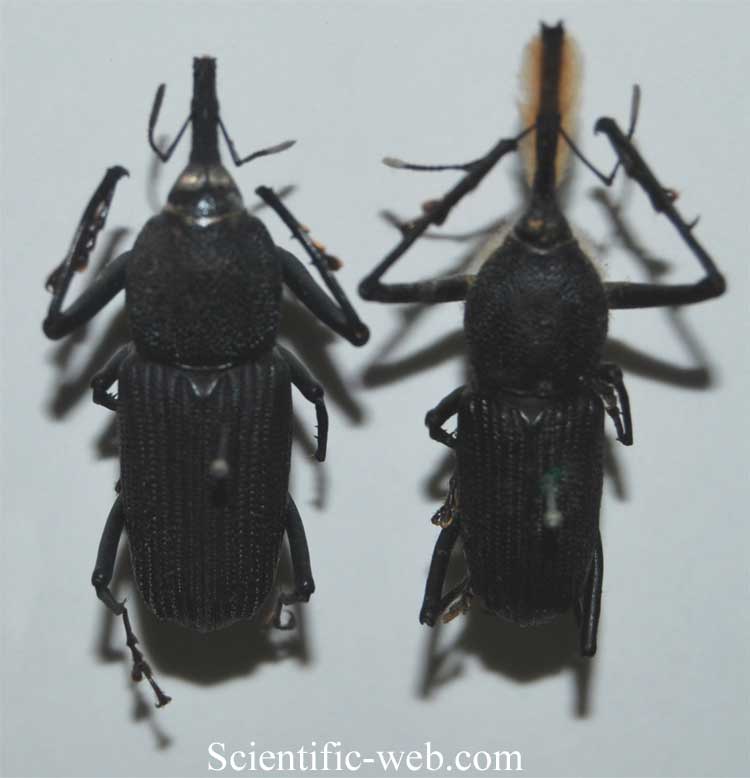
Rhinostomus barbirostris, Photo: Michael Lahanas
Superregnum: Eukaryota
Cladus: Unikonta
Cladus: Opisthokonta
Cladus: Holozoa
Regnum: Animalia
Subregnum: Eumetazoa
Cladus: Bilateria
Cladus: Nephrozoa
Cladus: Protostomia
Cladus: Ecdysozoa
Cladus: Panarthropoda
Phylum: Arthropoda
Subphylum: Hexapoda
Classis: Insecta
Cladus: Dicondylia
Subclassis: Pterygota
Cladus: Metapterygota
Infraclassis: Neoptera
Cladus: Eumetabola
Cladus: Endopterygota
Superordo: Coleopterida
Ordo: Coleoptera
Subordo: Polyphaga
Superfamilia: Curculionoidea
Familia: Curculionidae
Subfamilia: Dryophthorinae
Tribus: Rhinostomini
Genus: Rhinostomus
Species: Rhinostomus barbirostris
Name
Rhinostomus barbirostris (Fabricius, 1775)
Combinations
Rhina barbirostris
References
Primary references
Fabricius, J.C. 1775. Systema entomologiae, sistens insectorum classes, ordines, genera, species, adiectis synonymis, locis, descriptionibus, observationibus. Libraria Kortii, Flensburgi et Lipsiae. xvi+ 832 pp. DOI: 10.5962/bhl.title.36510. BHL. Reference page.
Additional references
Rejection of a proposal for the use of the Plenary Powers for the benefit of the generic name Rhina Latreille, [1802-1803] (Class Insecta, Order Coleoptera) and addition of the generic name Rhina Schneider, 1801 (Class Elasmobranchii) to the Official List
Behavior of adult bottle brush weevils (Rhinostomus barbirostris) (Coleoptera: Curculionidae).
Rhinostomus barbirostis (Fabricius) (Coleoptera: Curculionidae). Bearded weevil, bottle brush weevil.
Potential ecological implications of human entomophagy by subsistence groups of the Neotropics.
The importance of traditional ecological knowledge for palm-weevil cultivation in the Venezuelan Amazon.
Selected links
iNaturalist
Rhinostomus barbirostris, common name Bottlebrush Weevil or Bearded Weevil, is a species of true weevil family.
Description
Rhinostomus barbirostris can reach a length of 11–40 millimetres (0.43–1.57 in), excluding beak. It is probably the third largest weevil in the world. The basic color is black. The pronotum is as long as wide and densely punctate. The elytra bear distinct striae and are deeply punctate. Males have characteristic long reddish gold hairs on the apical portion of the long, straight, and dorsally dentate rostrum. The antennae are long and slender, and strongly elbowed. The front tibiae have two or more large, sharp teeth on the inner face. This species shows an unusual sexual polymorphism, as some males in each population are smaller than other males and resemble females.
Distribution
This common and widespread species occurs mainly in Central America and South America, while similar species in the genus occur in the United States, Africa, Madagascar, Borneo, and India.
References
Gwannon
Patricia Vaurie Weevils of the Tribe Sipalini (Coleoptera, Curculionidae, Rhynchophorinae) Part 1. The Genera Rhinostomus and Yuccaborus
Key to species of Rhinostomus
The smaller majority
Morrone, J.J., Cuevas, P.I. (2002) Cladistics of the pantropical genus Rhinostomus (Coleoptera: Curculionoidea: Dryophthoridae) with nomenclatural notes
Retrieved from "http://en.wikipedia.org/"
All text is available under the terms of the GNU Free Documentation License

